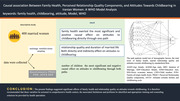- Record: found
- Abstract: found
- Article: found
Causal association between family health, perceived relationship quality components, and attitudes toward childbearing in Iranian women: A WHO model analysis

Read this article at
Abstract
Background
Given the unprecedented global decline in fertility as a major demographic development in recent years, the present study was conducted to determine Causal association Between Family Health, Perceived Relationship Quality Components, and Attitudes toward Childbearing in Iranian Women: A WHO Model Analysis
Methods
In 2023, this descriptive study recruited 400 married women presenting to selected comprehensive health centers affiliated to Alborz University of Medical Sciences, Karaj, Iran. The data were collected through multistage stratified cluster sampling and using a socioeconomic status questionnaire (Ghodratnama), the Perceived Relationship Quality Components (PRQC) scale, the family‐of‐origin scale (FOS), the attitudes toward fertility and childbearing scale (AFCS) and a demographic checklist were analyzed in SPSS 25 and LISREL 8.8.
Results
According to the path analysis, family health exerted the most significant and positive causal effect on attitudes to childbearing directly through one path ( B = 0.334) and relationship quality ( B = 0.698) and duration of married life ( B = 0.387) both directly and indirectly. The number of children ( B = –0.057), however, exerted the most significant and negative causal effect on attitudes to childbearing through both paths.
Conclusions
The present findings suggested the significant effects of family health and relationship quality on attitudes toward childbearing. It is therefore recommended that these variables be screened in comprehensive health centers, the associated limitations and problems be identified and appropriate training and counseling solutions be provided by health specialists.
Abstract
Related collections
Most cited references44
- Record: found
- Abstract: not found
- Article: not found
The Social Determinants of Health: It's Time to Consider the Causes of the Causes

- Record: found
- Abstract: found
- Article: found
The association of neighbourhood and individual social capital with consistent self-rated health: a longitudinal study in Brazilian pregnant and postpartum women
- Record: found
- Abstract: found
- Article: not found
